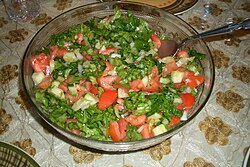 | |
| Type | Salad |
|---|---|
| Course | Mezze |
| Main ingredients | Vegetables, spices |
Arab salad or Arabic salad is any of a variety of salad dishes that form part of Arab cuisine. Combining many different fruits and spices, and often served as part of a mezze, Arab salads include those from Libya and Tunisia such as the "Tunisian salad" and "black olive and orange salad" (salatat zaytoon) and from Tunisia salata machwiya is a grilled salad made from peppers, tomatoes, garlic and onions with olives and tuna on top, those from Syria and Lebanon such as "artichoke salad" (salataf khurshoof) and "beet salad" (salatat shamandar), and those from Palestine and Jordan. [1] Other popular Arab salads eaten throughout the Arab world include fattoush and tabouli. [2] [3]
Contents
A recipe for Arab salad in Woman's Day magazine includes diced tomato, cucumber and onion. [4] Often mixed with fresh parsley, mint, basil, or thyme and combined with the juice of freshly squeezed lemon and olive oil, Arabic salad contains no lettuce. All the vegetables, except the onion, are left unpeeled, and the salad should be served immediately. Other variations include serving with fried pita slices or adding sumac to the lemon and oil dressing. [5]